LCBB4002 Community Engagement: Project Analysis & Stakeholder Role
VerifiedAdded on 2023/06/10
|10
|2755
|250
Report
AI Summary
This report provides a detailed analysis of a community engagement project focused on addressing social and economic development through community building and food distribution to needy individuals. It explores the principles of community engagement, the importance of stakeholder participation, and various community development approaches. The report highlights the use of social media platforms for project promotion and coordination. It emphasizes the benefits of community meals in fostering social connections and addressing food insecurity. Furthermore, the report discusses key concepts such as thoughtful planning, inclusiveness, cooperation, and honesty in ensuring successful community outreach. It also addresses the importance of incorporating community stakeholder input from the beginning to ensure that the project aligns with the needs and opinions of the community, ultimately increasing the likelihood of success.
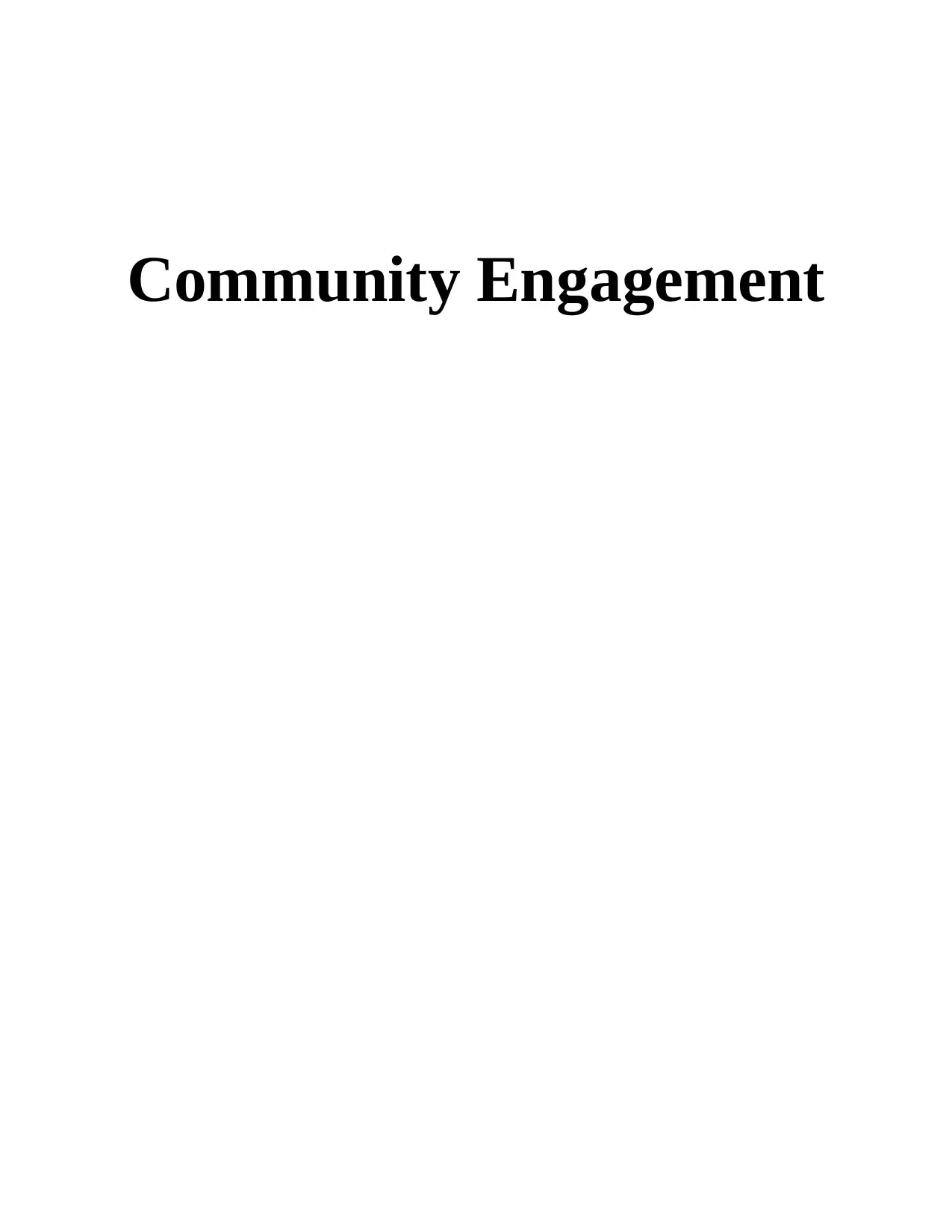
Community Engagement
Paraphrase This Document
Need a fresh take? Get an instant paraphrase of this document with our AI Paraphraser

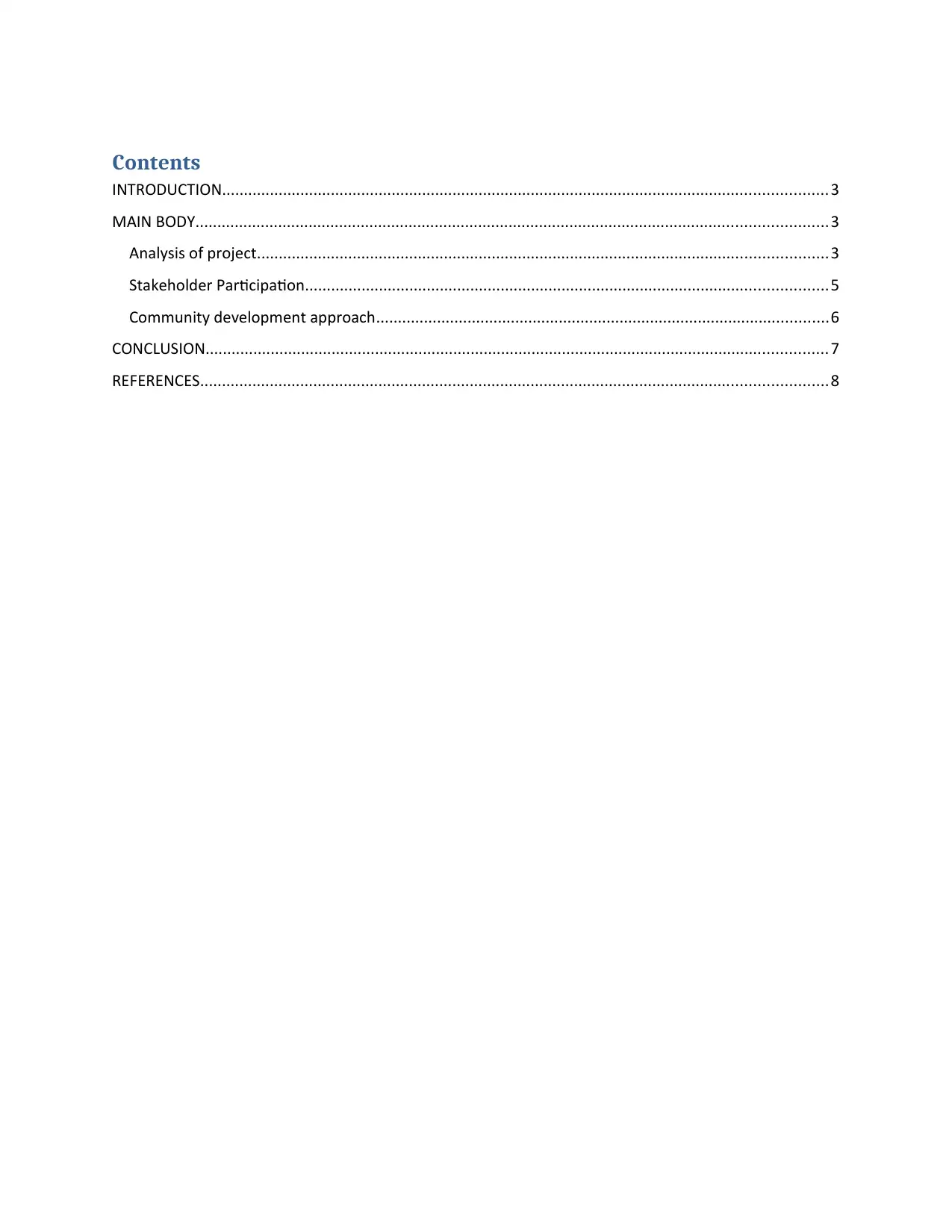
Contents
INTRODUCTION...........................................................................................................................................3
MAIN BODY.................................................................................................................................................3
Analysis of project...................................................................................................................................3
Stakeholder Participation........................................................................................................................5
Community development approach........................................................................................................6
CONCLUSION...............................................................................................................................................7
REFERENCES................................................................................................................................................8
INTRODUCTION...........................................................................................................................................3
MAIN BODY.................................................................................................................................................3
Analysis of project...................................................................................................................................3
Stakeholder Participation........................................................................................................................5
Community development approach........................................................................................................6
CONCLUSION...............................................................................................................................................7
REFERENCES................................................................................................................................................8
⊘ This is a preview!⊘
Do you want full access?
Subscribe today to unlock all pages.

Trusted by 1+ million students worldwide
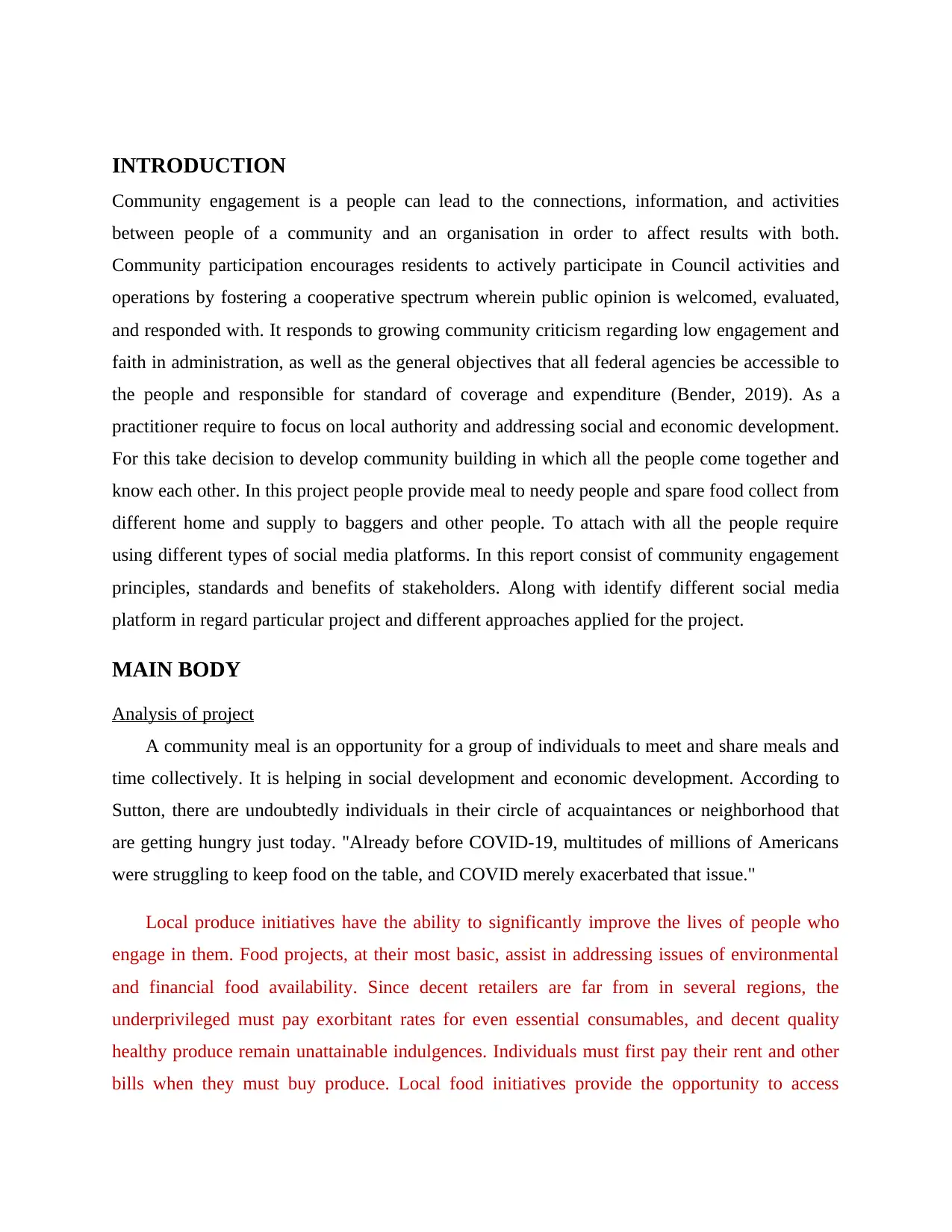
INTRODUCTION
Community engagement is a people can lead to the connections, information, and activities
between people of a community and an organisation in order to affect results with both.
Community participation encourages residents to actively participate in Council activities and
operations by fostering a cooperative spectrum wherein public opinion is welcomed, evaluated,
and responded with. It responds to growing community criticism regarding low engagement and
faith in administration, as well as the general objectives that all federal agencies be accessible to
the people and responsible for standard of coverage and expenditure (Bender, 2019). As a
practitioner require to focus on local authority and addressing social and economic development.
For this take decision to develop community building in which all the people come together and
know each other. In this project people provide meal to needy people and spare food collect from
different home and supply to baggers and other people. To attach with all the people require
using different types of social media platforms. In this report consist of community engagement
principles, standards and benefits of stakeholders. Along with identify different social media
platform in regard particular project and different approaches applied for the project.
MAIN BODY
Analysis of project
A community meal is an opportunity for a group of individuals to meet and share meals and
time collectively. It is helping in social development and economic development. According to
Sutton, there are undoubtedly individuals in their circle of acquaintances or neighborhood that
are getting hungry just today. "Already before COVID-19, multitudes of millions of Americans
were struggling to keep food on the table, and COVID merely exacerbated that issue."
Local produce initiatives have the ability to significantly improve the lives of people who
engage in them. Food projects, at their most basic, assist in addressing issues of environmental
and financial food availability. Since decent retailers are far from in several regions, the
underprivileged must pay exorbitant rates for even essential consumables, and decent quality
healthy produce remain unattainable indulgences. Individuals must first pay their rent and other
bills when they must buy produce. Local food initiatives provide the opportunity to access
Community engagement is a people can lead to the connections, information, and activities
between people of a community and an organisation in order to affect results with both.
Community participation encourages residents to actively participate in Council activities and
operations by fostering a cooperative spectrum wherein public opinion is welcomed, evaluated,
and responded with. It responds to growing community criticism regarding low engagement and
faith in administration, as well as the general objectives that all federal agencies be accessible to
the people and responsible for standard of coverage and expenditure (Bender, 2019). As a
practitioner require to focus on local authority and addressing social and economic development.
For this take decision to develop community building in which all the people come together and
know each other. In this project people provide meal to needy people and spare food collect from
different home and supply to baggers and other people. To attach with all the people require
using different types of social media platforms. In this report consist of community engagement
principles, standards and benefits of stakeholders. Along with identify different social media
platform in regard particular project and different approaches applied for the project.
MAIN BODY
Analysis of project
A community meal is an opportunity for a group of individuals to meet and share meals and
time collectively. It is helping in social development and economic development. According to
Sutton, there are undoubtedly individuals in their circle of acquaintances or neighborhood that
are getting hungry just today. "Already before COVID-19, multitudes of millions of Americans
were struggling to keep food on the table, and COVID merely exacerbated that issue."
Local produce initiatives have the ability to significantly improve the lives of people who
engage in them. Food projects, at their most basic, assist in addressing issues of environmental
and financial food availability. Since decent retailers are far from in several regions, the
underprivileged must pay exorbitant rates for even essential consumables, and decent quality
healthy produce remain unattainable indulgences. Individuals must first pay their rent and other
bills when they must buy produce. Local food initiatives provide the opportunity to access
Paraphrase This Document
Need a fresh take? Get an instant paraphrase of this document with our AI Paraphraser
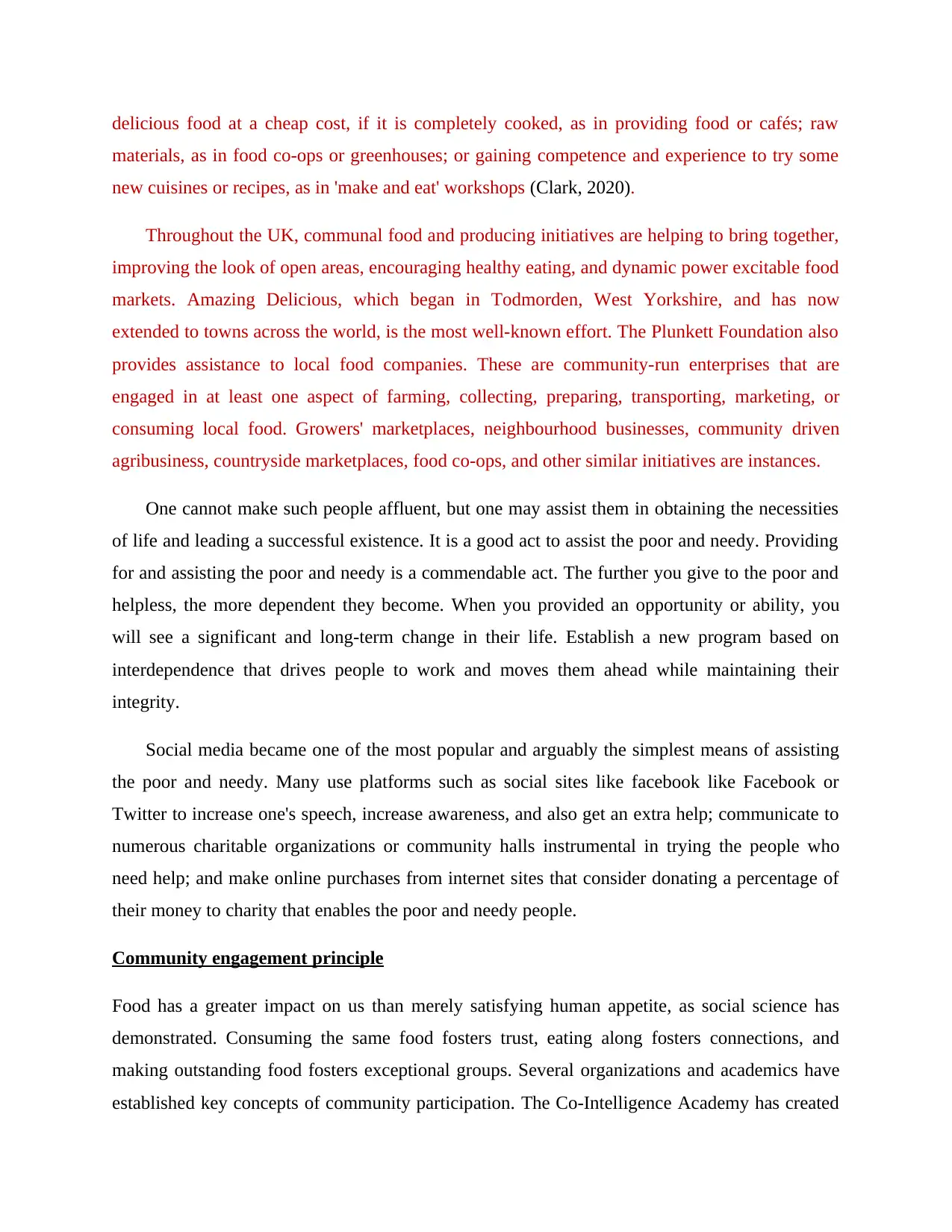
delicious food at a cheap cost, if it is completely cooked, as in providing food or cafés; raw
materials, as in food co-ops or greenhouses; or gaining competence and experience to try some
new cuisines or recipes, as in 'make and eat' workshops (Clark, 2020).
Throughout the UK, communal food and producing initiatives are helping to bring together,
improving the look of open areas, encouraging healthy eating, and dynamic power excitable food
markets. Amazing Delicious, which began in Todmorden, West Yorkshire, and has now
extended to towns across the world, is the most well-known effort. The Plunkett Foundation also
provides assistance to local food companies. These are community-run enterprises that are
engaged in at least one aspect of farming, collecting, preparing, transporting, marketing, or
consuming local food. Growers' marketplaces, neighbourhood businesses, community driven
agribusiness, countryside marketplaces, food co-ops, and other similar initiatives are instances.
One cannot make such people affluent, but one may assist them in obtaining the necessities
of life and leading a successful existence. It is a good act to assist the poor and needy. Providing
for and assisting the poor and needy is a commendable act. The further you give to the poor and
helpless, the more dependent they become. When you provided an opportunity or ability, you
will see a significant and long-term change in their life. Establish a new program based on
interdependence that drives people to work and moves them ahead while maintaining their
integrity.
Social media became one of the most popular and arguably the simplest means of assisting
the poor and needy. Many use platforms such as social sites like facebook like Facebook or
Twitter to increase one's speech, increase awareness, and also get an extra help; communicate to
numerous charitable organizations or community halls instrumental in trying the people who
need help; and make online purchases from internet sites that consider donating a percentage of
their money to charity that enables the poor and needy people.
Community engagement principle
Food has a greater impact on us than merely satisfying human appetite, as social science has
demonstrated. Consuming the same food fosters trust, eating along fosters connections, and
making outstanding food fosters exceptional groups. Several organizations and academics have
established key concepts of community participation. The Co-Intelligence Academy has created
materials, as in food co-ops or greenhouses; or gaining competence and experience to try some
new cuisines or recipes, as in 'make and eat' workshops (Clark, 2020).
Throughout the UK, communal food and producing initiatives are helping to bring together,
improving the look of open areas, encouraging healthy eating, and dynamic power excitable food
markets. Amazing Delicious, which began in Todmorden, West Yorkshire, and has now
extended to towns across the world, is the most well-known effort. The Plunkett Foundation also
provides assistance to local food companies. These are community-run enterprises that are
engaged in at least one aspect of farming, collecting, preparing, transporting, marketing, or
consuming local food. Growers' marketplaces, neighbourhood businesses, community driven
agribusiness, countryside marketplaces, food co-ops, and other similar initiatives are instances.
One cannot make such people affluent, but one may assist them in obtaining the necessities
of life and leading a successful existence. It is a good act to assist the poor and needy. Providing
for and assisting the poor and needy is a commendable act. The further you give to the poor and
helpless, the more dependent they become. When you provided an opportunity or ability, you
will see a significant and long-term change in their life. Establish a new program based on
interdependence that drives people to work and moves them ahead while maintaining their
integrity.
Social media became one of the most popular and arguably the simplest means of assisting
the poor and needy. Many use platforms such as social sites like facebook like Facebook or
Twitter to increase one's speech, increase awareness, and also get an extra help; communicate to
numerous charitable organizations or community halls instrumental in trying the people who
need help; and make online purchases from internet sites that consider donating a percentage of
their money to charity that enables the poor and needy people.
Community engagement principle
Food has a greater impact on us than merely satisfying human appetite, as social science has
demonstrated. Consuming the same food fosters trust, eating along fosters connections, and
making outstanding food fosters exceptional groups. Several organizations and academics have
established key concepts of community participation. The Co-Intelligence Academy has created
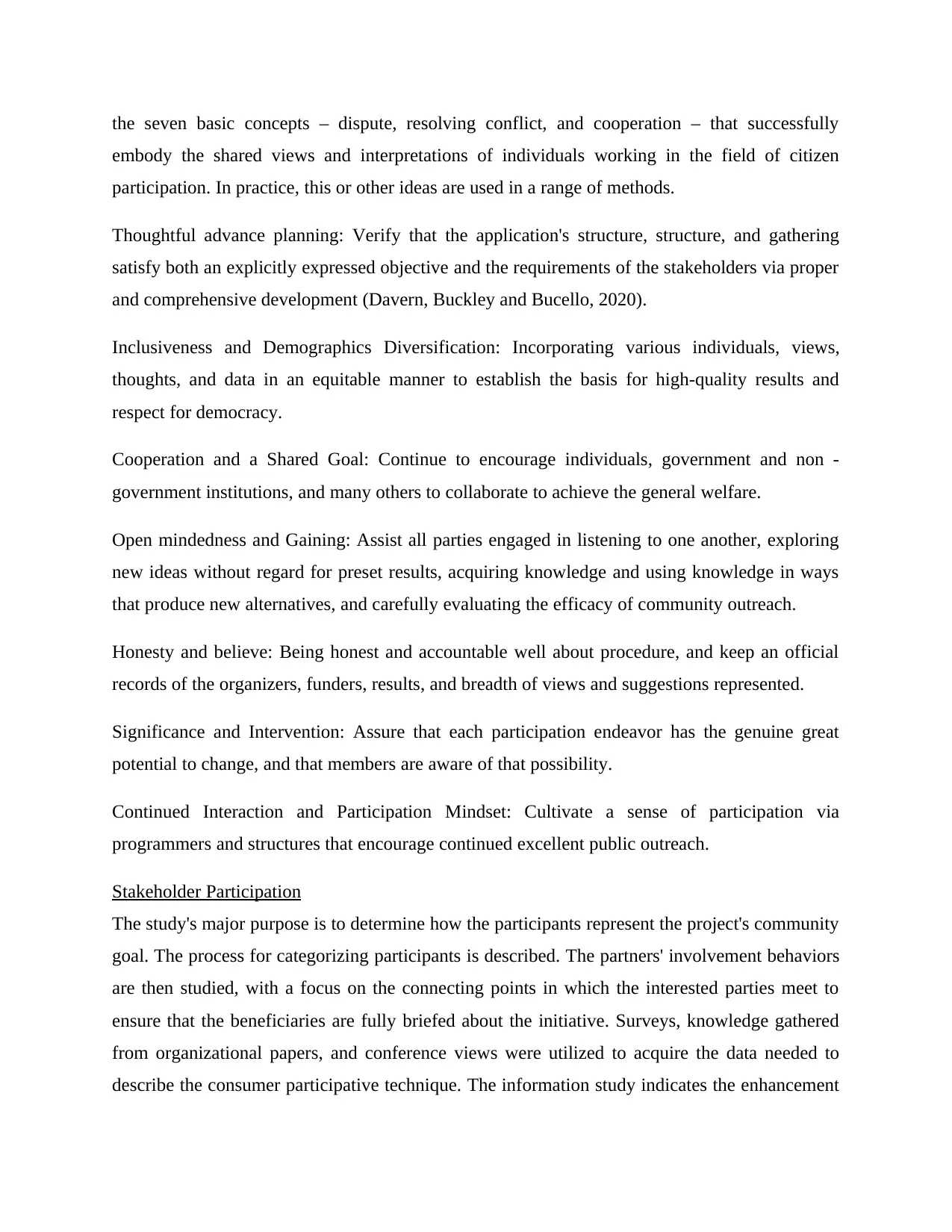
the seven basic concepts – dispute, resolving conflict, and cooperation – that successfully
embody the shared views and interpretations of individuals working in the field of citizen
participation. In practice, this or other ideas are used in a range of methods.
Thoughtful advance planning: Verify that the application's structure, structure, and gathering
satisfy both an explicitly expressed objective and the requirements of the stakeholders via proper
and comprehensive development (Davern, Buckley and Bucello, 2020).
Inclusiveness and Demographics Diversification: Incorporating various individuals, views,
thoughts, and data in an equitable manner to establish the basis for high-quality results and
respect for democracy.
Cooperation and a Shared Goal: Continue to encourage individuals, government and non -
government institutions, and many others to collaborate to achieve the general welfare.
Open mindedness and Gaining: Assist all parties engaged in listening to one another, exploring
new ideas without regard for preset results, acquiring knowledge and using knowledge in ways
that produce new alternatives, and carefully evaluating the efficacy of community outreach.
Honesty and believe: Being honest and accountable well about procedure, and keep an official
records of the organizers, funders, results, and breadth of views and suggestions represented.
Significance and Intervention: Assure that each participation endeavor has the genuine great
potential to change, and that members are aware of that possibility.
Continued Interaction and Participation Mindset: Cultivate a sense of participation via
programmers and structures that encourage continued excellent public outreach.
Stakeholder Participation
The study's major purpose is to determine how the participants represent the project's community
goal. The process for categorizing participants is described. The partners' involvement behaviors
are then studied, with a focus on the connecting points in which the interested parties meet to
ensure that the beneficiaries are fully briefed about the initiative. Surveys, knowledge gathered
from organizational papers, and conference views were utilized to acquire the data needed to
describe the consumer participative technique. The information study indicates the enhancement
embody the shared views and interpretations of individuals working in the field of citizen
participation. In practice, this or other ideas are used in a range of methods.
Thoughtful advance planning: Verify that the application's structure, structure, and gathering
satisfy both an explicitly expressed objective and the requirements of the stakeholders via proper
and comprehensive development (Davern, Buckley and Bucello, 2020).
Inclusiveness and Demographics Diversification: Incorporating various individuals, views,
thoughts, and data in an equitable manner to establish the basis for high-quality results and
respect for democracy.
Cooperation and a Shared Goal: Continue to encourage individuals, government and non -
government institutions, and many others to collaborate to achieve the general welfare.
Open mindedness and Gaining: Assist all parties engaged in listening to one another, exploring
new ideas without regard for preset results, acquiring knowledge and using knowledge in ways
that produce new alternatives, and carefully evaluating the efficacy of community outreach.
Honesty and believe: Being honest and accountable well about procedure, and keep an official
records of the organizers, funders, results, and breadth of views and suggestions represented.
Significance and Intervention: Assure that each participation endeavor has the genuine great
potential to change, and that members are aware of that possibility.
Continued Interaction and Participation Mindset: Cultivate a sense of participation via
programmers and structures that encourage continued excellent public outreach.
Stakeholder Participation
The study's major purpose is to determine how the participants represent the project's community
goal. The process for categorizing participants is described. The partners' involvement behaviors
are then studied, with a focus on the connecting points in which the interested parties meet to
ensure that the beneficiaries are fully briefed about the initiative. Surveys, knowledge gathered
from organizational papers, and conference views were utilized to acquire the data needed to
describe the consumer participative technique. The information study indicates the enhancement
⊘ This is a preview!⊘
Do you want full access?
Subscribe today to unlock all pages.

Trusted by 1+ million students worldwide
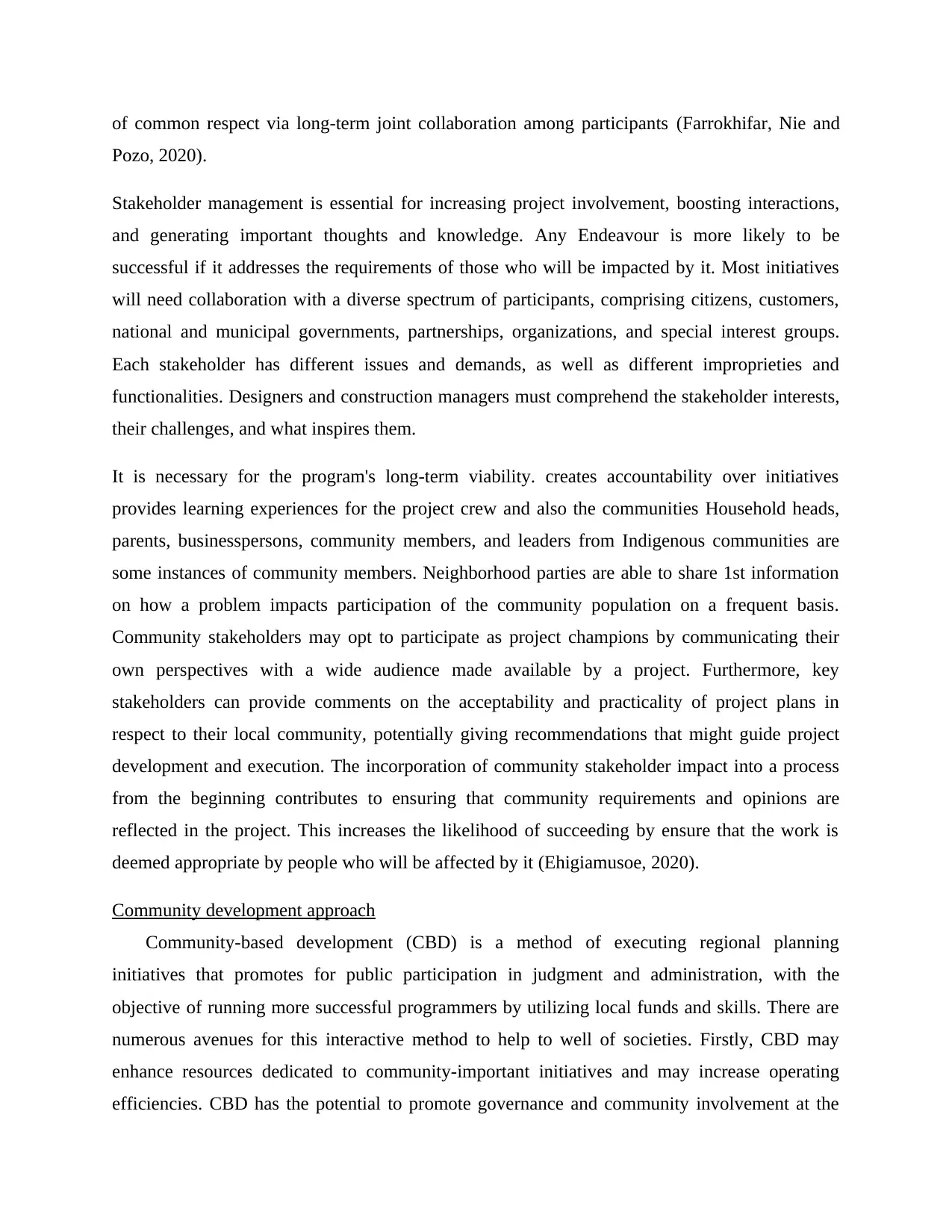
of common respect via long-term joint collaboration among participants (Farrokhifar, Nie and
Pozo, 2020).
Stakeholder management is essential for increasing project involvement, boosting interactions,
and generating important thoughts and knowledge. Any Endeavour is more likely to be
successful if it addresses the requirements of those who will be impacted by it. Most initiatives
will need collaboration with a diverse spectrum of participants, comprising citizens, customers,
national and municipal governments, partnerships, organizations, and special interest groups.
Each stakeholder has different issues and demands, as well as different improprieties and
functionalities. Designers and construction managers must comprehend the stakeholder interests,
their challenges, and what inspires them.
It is necessary for the program's long-term viability. creates accountability over initiatives
provides learning experiences for the project crew and also the communities Household heads,
parents, businesspersons, community members, and leaders from Indigenous communities are
some instances of community members. Neighborhood parties are able to share 1st information
on how a problem impacts participation of the community population on a frequent basis.
Community stakeholders may opt to participate as project champions by communicating their
own perspectives with a wide audience made available by a project. Furthermore, key
stakeholders can provide comments on the acceptability and practicality of project plans in
respect to their local community, potentially giving recommendations that might guide project
development and execution. The incorporation of community stakeholder impact into a process
from the beginning contributes to ensuring that community requirements and opinions are
reflected in the project. This increases the likelihood of succeeding by ensure that the work is
deemed appropriate by people who will be affected by it (Ehigiamusoe, 2020).
Community development approach
Community-based development (CBD) is a method of executing regional planning
initiatives that promotes for public participation in judgment and administration, with the
objective of running more successful programmers by utilizing local funds and skills. There are
numerous avenues for this interactive method to help to well of societies. Firstly, CBD may
enhance resources dedicated to community-important initiatives and may increase operating
efficiencies. CBD has the potential to promote governance and community involvement at the
Pozo, 2020).
Stakeholder management is essential for increasing project involvement, boosting interactions,
and generating important thoughts and knowledge. Any Endeavour is more likely to be
successful if it addresses the requirements of those who will be impacted by it. Most initiatives
will need collaboration with a diverse spectrum of participants, comprising citizens, customers,
national and municipal governments, partnerships, organizations, and special interest groups.
Each stakeholder has different issues and demands, as well as different improprieties and
functionalities. Designers and construction managers must comprehend the stakeholder interests,
their challenges, and what inspires them.
It is necessary for the program's long-term viability. creates accountability over initiatives
provides learning experiences for the project crew and also the communities Household heads,
parents, businesspersons, community members, and leaders from Indigenous communities are
some instances of community members. Neighborhood parties are able to share 1st information
on how a problem impacts participation of the community population on a frequent basis.
Community stakeholders may opt to participate as project champions by communicating their
own perspectives with a wide audience made available by a project. Furthermore, key
stakeholders can provide comments on the acceptability and practicality of project plans in
respect to their local community, potentially giving recommendations that might guide project
development and execution. The incorporation of community stakeholder impact into a process
from the beginning contributes to ensuring that community requirements and opinions are
reflected in the project. This increases the likelihood of succeeding by ensure that the work is
deemed appropriate by people who will be affected by it (Ehigiamusoe, 2020).
Community development approach
Community-based development (CBD) is a method of executing regional planning
initiatives that promotes for public participation in judgment and administration, with the
objective of running more successful programmers by utilizing local funds and skills. There are
numerous avenues for this interactive method to help to well of societies. Firstly, CBD may
enhance resources dedicated to community-important initiatives and may increase operating
efficiencies. CBD has the potential to promote governance and community involvement at the
Paraphrase This Document
Need a fresh take? Get an instant paraphrase of this document with our AI Paraphraser
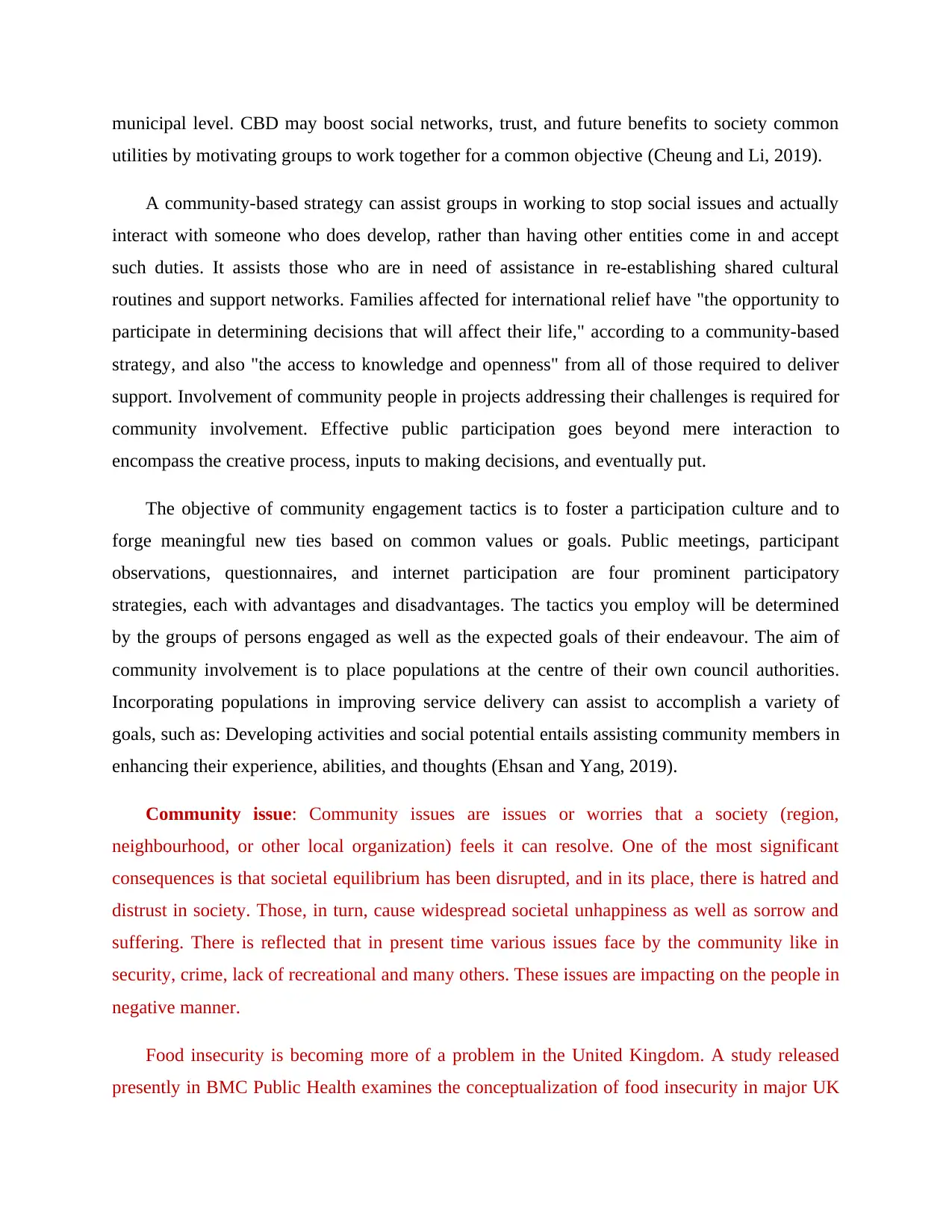
municipal level. CBD may boost social networks, trust, and future benefits to society common
utilities by motivating groups to work together for a common objective (Cheung and Li, 2019).
A community-based strategy can assist groups in working to stop social issues and actually
interact with someone who does develop, rather than having other entities come in and accept
such duties. It assists those who are in need of assistance in re-establishing shared cultural
routines and support networks. Families affected for international relief have "the opportunity to
participate in determining decisions that will affect their life," according to a community-based
strategy, and also "the access to knowledge and openness" from all of those required to deliver
support. Involvement of community people in projects addressing their challenges is required for
community involvement. Effective public participation goes beyond mere interaction to
encompass the creative process, inputs to making decisions, and eventually put.
The objective of community engagement tactics is to foster a participation culture and to
forge meaningful new ties based on common values or goals. Public meetings, participant
observations, questionnaires, and internet participation are four prominent participatory
strategies, each with advantages and disadvantages. The tactics you employ will be determined
by the groups of persons engaged as well as the expected goals of their endeavour. The aim of
community involvement is to place populations at the centre of their own council authorities.
Incorporating populations in improving service delivery can assist to accomplish a variety of
goals, such as: Developing activities and social potential entails assisting community members in
enhancing their experience, abilities, and thoughts (Ehsan and Yang, 2019).
Community issue: Community issues are issues or worries that a society (region,
neighbourhood, or other local organization) feels it can resolve. One of the most significant
consequences is that societal equilibrium has been disrupted, and in its place, there is hatred and
distrust in society. Those, in turn, cause widespread societal unhappiness as well as sorrow and
suffering. There is reflected that in present time various issues face by the community like in
security, crime, lack of recreational and many others. These issues are impacting on the people in
negative manner.
Food insecurity is becoming more of a problem in the United Kingdom. A study released
presently in BMC Public Health examines the conceptualization of food insecurity in major UK
utilities by motivating groups to work together for a common objective (Cheung and Li, 2019).
A community-based strategy can assist groups in working to stop social issues and actually
interact with someone who does develop, rather than having other entities come in and accept
such duties. It assists those who are in need of assistance in re-establishing shared cultural
routines and support networks. Families affected for international relief have "the opportunity to
participate in determining decisions that will affect their life," according to a community-based
strategy, and also "the access to knowledge and openness" from all of those required to deliver
support. Involvement of community people in projects addressing their challenges is required for
community involvement. Effective public participation goes beyond mere interaction to
encompass the creative process, inputs to making decisions, and eventually put.
The objective of community engagement tactics is to foster a participation culture and to
forge meaningful new ties based on common values or goals. Public meetings, participant
observations, questionnaires, and internet participation are four prominent participatory
strategies, each with advantages and disadvantages. The tactics you employ will be determined
by the groups of persons engaged as well as the expected goals of their endeavour. The aim of
community involvement is to place populations at the centre of their own council authorities.
Incorporating populations in improving service delivery can assist to accomplish a variety of
goals, such as: Developing activities and social potential entails assisting community members in
enhancing their experience, abilities, and thoughts (Ehsan and Yang, 2019).
Community issue: Community issues are issues or worries that a society (region,
neighbourhood, or other local organization) feels it can resolve. One of the most significant
consequences is that societal equilibrium has been disrupted, and in its place, there is hatred and
distrust in society. Those, in turn, cause widespread societal unhappiness as well as sorrow and
suffering. There is reflected that in present time various issues face by the community like in
security, crime, lack of recreational and many others. These issues are impacting on the people in
negative manner.
Food insecurity is becoming more of a problem in the United Kingdom. A study released
presently in BMC Public Health examines the conceptualization of food insecurity in major UK
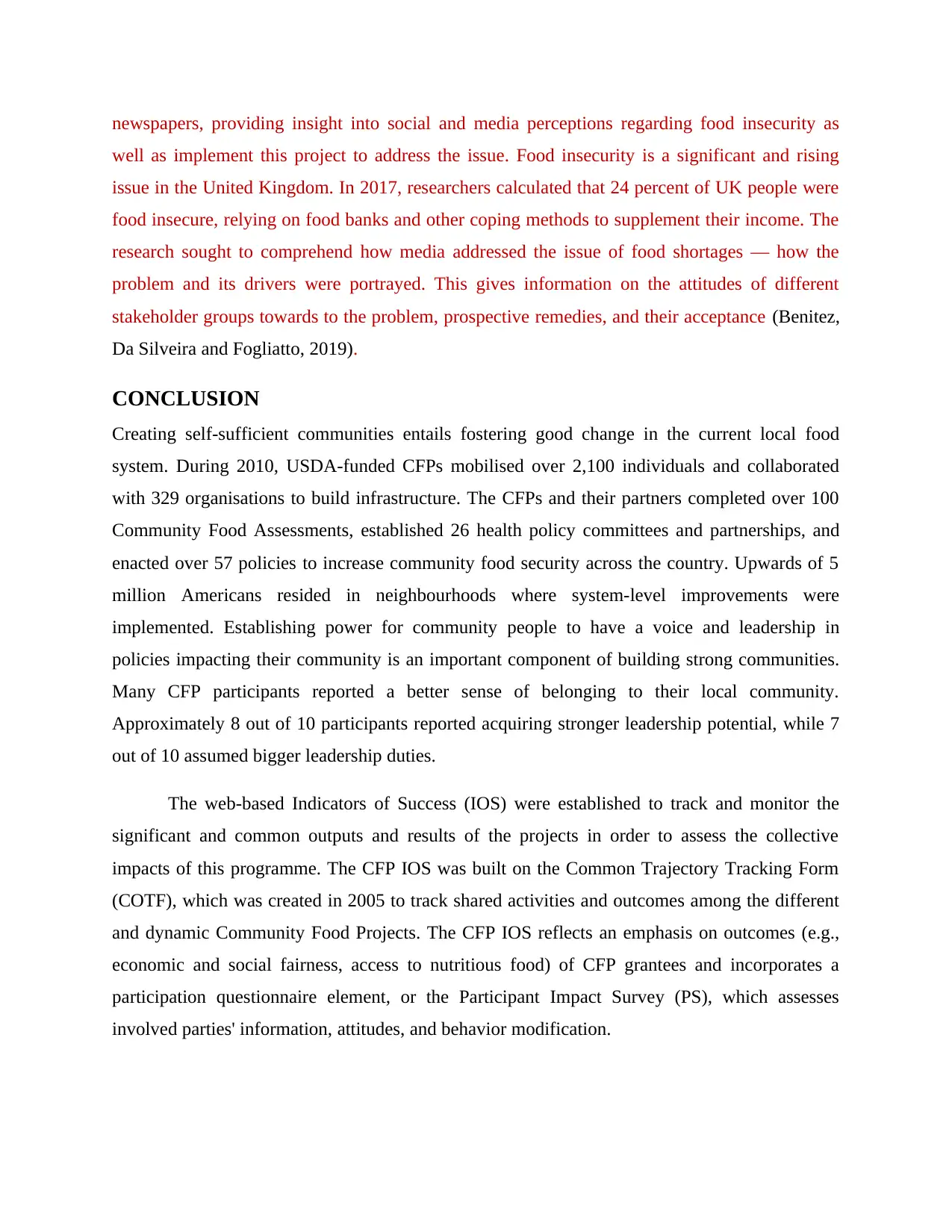
newspapers, providing insight into social and media perceptions regarding food insecurity as
well as implement this project to address the issue. Food insecurity is a significant and rising
issue in the United Kingdom. In 2017, researchers calculated that 24 percent of UK people were
food insecure, relying on food banks and other coping methods to supplement their income. The
research sought to comprehend how media addressed the issue of food shortages — how the
problem and its drivers were portrayed. This gives information on the attitudes of different
stakeholder groups towards to the problem, prospective remedies, and their acceptance (Benitez,
Da Silveira and Fogliatto, 2019).
CONCLUSION
Creating self-sufficient communities entails fostering good change in the current local food
system. During 2010, USDA-funded CFPs mobilised over 2,100 individuals and collaborated
with 329 organisations to build infrastructure. The CFPs and their partners completed over 100
Community Food Assessments, established 26 health policy committees and partnerships, and
enacted over 57 policies to increase community food security across the country. Upwards of 5
million Americans resided in neighbourhoods where system-level improvements were
implemented. Establishing power for community people to have a voice and leadership in
policies impacting their community is an important component of building strong communities.
Many CFP participants reported a better sense of belonging to their local community.
Approximately 8 out of 10 participants reported acquiring stronger leadership potential, while 7
out of 10 assumed bigger leadership duties.
The web-based Indicators of Success (IOS) were established to track and monitor the
significant and common outputs and results of the projects in order to assess the collective
impacts of this programme. The CFP IOS was built on the Common Trajectory Tracking Form
(COTF), which was created in 2005 to track shared activities and outcomes among the different
and dynamic Community Food Projects. The CFP IOS reflects an emphasis on outcomes (e.g.,
economic and social fairness, access to nutritious food) of CFP grantees and incorporates a
participation questionnaire element, or the Participant Impact Survey (PS), which assesses
involved parties' information, attitudes, and behavior modification.
well as implement this project to address the issue. Food insecurity is a significant and rising
issue in the United Kingdom. In 2017, researchers calculated that 24 percent of UK people were
food insecure, relying on food banks and other coping methods to supplement their income. The
research sought to comprehend how media addressed the issue of food shortages — how the
problem and its drivers were portrayed. This gives information on the attitudes of different
stakeholder groups towards to the problem, prospective remedies, and their acceptance (Benitez,
Da Silveira and Fogliatto, 2019).
CONCLUSION
Creating self-sufficient communities entails fostering good change in the current local food
system. During 2010, USDA-funded CFPs mobilised over 2,100 individuals and collaborated
with 329 organisations to build infrastructure. The CFPs and their partners completed over 100
Community Food Assessments, established 26 health policy committees and partnerships, and
enacted over 57 policies to increase community food security across the country. Upwards of 5
million Americans resided in neighbourhoods where system-level improvements were
implemented. Establishing power for community people to have a voice and leadership in
policies impacting their community is an important component of building strong communities.
Many CFP participants reported a better sense of belonging to their local community.
Approximately 8 out of 10 participants reported acquiring stronger leadership potential, while 7
out of 10 assumed bigger leadership duties.
The web-based Indicators of Success (IOS) were established to track and monitor the
significant and common outputs and results of the projects in order to assess the collective
impacts of this programme. The CFP IOS was built on the Common Trajectory Tracking Form
(COTF), which was created in 2005 to track shared activities and outcomes among the different
and dynamic Community Food Projects. The CFP IOS reflects an emphasis on outcomes (e.g.,
economic and social fairness, access to nutritious food) of CFP grantees and incorporates a
participation questionnaire element, or the Participant Impact Survey (PS), which assesses
involved parties' information, attitudes, and behavior modification.
⊘ This is a preview!⊘
Do you want full access?
Subscribe today to unlock all pages.

Trusted by 1+ million students worldwide
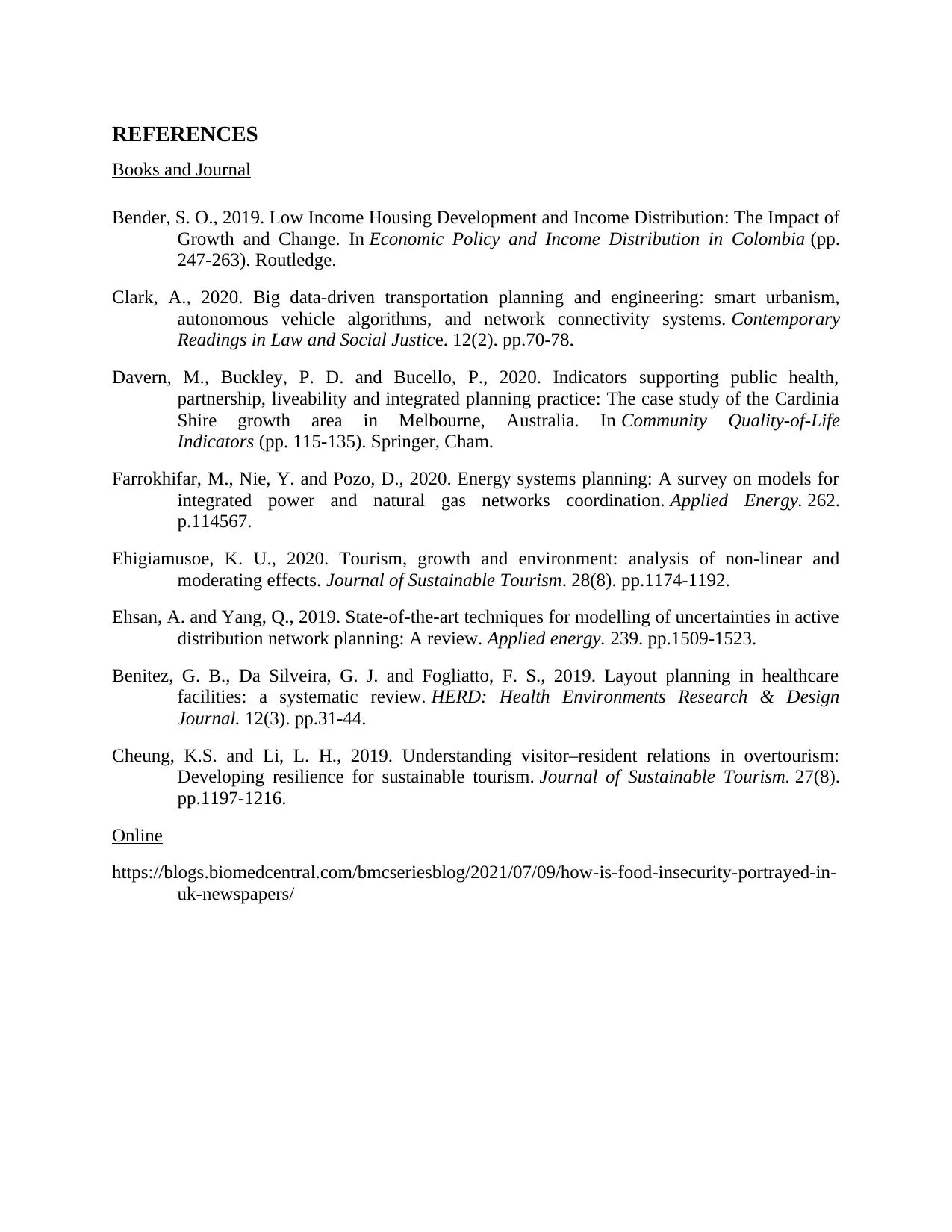
REFERENCES
Books and Journal
Bender, S. O., 2019. Low Income Housing Development and Income Distribution: The Impact of
Growth and Change. In Economic Policy and Income Distribution in Colombia (pp.
247-263). Routledge.
Clark, A., 2020. Big data-driven transportation planning and engineering: smart urbanism,
autonomous vehicle algorithms, and network connectivity systems. Contemporary
Readings in Law and Social Justice. 12(2). pp.70-78.
Davern, M., Buckley, P. D. and Bucello, P., 2020. Indicators supporting public health,
partnership, liveability and integrated planning practice: The case study of the Cardinia
Shire growth area in Melbourne, Australia. In Community Quality-of-Life
Indicators (pp. 115-135). Springer, Cham.
Farrokhifar, M., Nie, Y. and Pozo, D., 2020. Energy systems planning: A survey on models for
integrated power and natural gas networks coordination. Applied Energy. 262.
p.114567.
Ehigiamusoe, K. U., 2020. Tourism, growth and environment: analysis of non-linear and
moderating effects. Journal of Sustainable Tourism. 28(8). pp.1174-1192.
Ehsan, A. and Yang, Q., 2019. State-of-the-art techniques for modelling of uncertainties in active
distribution network planning: A review. Applied energy. 239. pp.1509-1523.
Benitez, G. B., Da Silveira, G. J. and Fogliatto, F. S., 2019. Layout planning in healthcare
facilities: a systematic review. HERD: Health Environments Research & Design
Journal. 12(3). pp.31-44.
Cheung, K.S. and Li, L. H., 2019. Understanding visitor–resident relations in overtourism:
Developing resilience for sustainable tourism. Journal of Sustainable Tourism. 27(8).
pp.1197-1216.
Online
https://blogs.biomedcentral.com/bmcseriesblog/2021/07/09/how-is-food-insecurity-portrayed-in-
uk-newspapers/
Books and Journal
Bender, S. O., 2019. Low Income Housing Development and Income Distribution: The Impact of
Growth and Change. In Economic Policy and Income Distribution in Colombia (pp.
247-263). Routledge.
Clark, A., 2020. Big data-driven transportation planning and engineering: smart urbanism,
autonomous vehicle algorithms, and network connectivity systems. Contemporary
Readings in Law and Social Justice. 12(2). pp.70-78.
Davern, M., Buckley, P. D. and Bucello, P., 2020. Indicators supporting public health,
partnership, liveability and integrated planning practice: The case study of the Cardinia
Shire growth area in Melbourne, Australia. In Community Quality-of-Life
Indicators (pp. 115-135). Springer, Cham.
Farrokhifar, M., Nie, Y. and Pozo, D., 2020. Energy systems planning: A survey on models for
integrated power and natural gas networks coordination. Applied Energy. 262.
p.114567.
Ehigiamusoe, K. U., 2020. Tourism, growth and environment: analysis of non-linear and
moderating effects. Journal of Sustainable Tourism. 28(8). pp.1174-1192.
Ehsan, A. and Yang, Q., 2019. State-of-the-art techniques for modelling of uncertainties in active
distribution network planning: A review. Applied energy. 239. pp.1509-1523.
Benitez, G. B., Da Silveira, G. J. and Fogliatto, F. S., 2019. Layout planning in healthcare
facilities: a systematic review. HERD: Health Environments Research & Design
Journal. 12(3). pp.31-44.
Cheung, K.S. and Li, L. H., 2019. Understanding visitor–resident relations in overtourism:
Developing resilience for sustainable tourism. Journal of Sustainable Tourism. 27(8).
pp.1197-1216.
Online
https://blogs.biomedcentral.com/bmcseriesblog/2021/07/09/how-is-food-insecurity-portrayed-in-
uk-newspapers/
1 out of 10
Related Documents
Your All-in-One AI-Powered Toolkit for Academic Success.
+13062052269
info@desklib.com
Available 24*7 on WhatsApp / Email
![[object Object]](/_next/static/media/star-bottom.7253800d.svg)
Unlock your academic potential
Copyright © 2020–2025 A2Z Services. All Rights Reserved. Developed and managed by ZUCOL.




